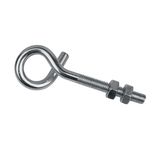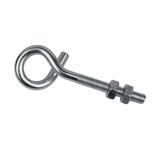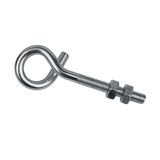Schmersal Cable inlet







Schmersal Cable Glands for cabinets and machines
Schmersal’s cable termination hardware helps panel shops and machine builders route, seal, and relieve conductors without guesswork. Metric and PG threads cover typical gland plates and field enclosures; clamping ranges are documented for each size so installers can match jacket OD precisely. Materials span polyamide PA6/PA66 (halogen-free), nickel-plated brass for robust threading, and stainless steel for wash-down or corrosive zones. Hygienic variants reach IP69K; general-purpose lines meet IP66/IP68 per IEC 60529 when tightened to the specified torque.
Families are grouped by function so you can standardize across platforms:
- General sealing glands with double or progressive seals in TPE/EPDM; typical sizes M12…M63. Dome nuts accept torque tools; locknuts include anti-rotation features for thin plates.
- EMC glands with 360° braid termination springs that clamp the shield circumferentially to cut pigtail inductance—ideal on VFD motor leads and high-speed I/O.
- Hygienic/IP69K glands with smooth geometry, blue FDA-compliant silicone seals, and stainless bodies for CIP/SIP areas.
- Multi-hole inserts for compact routing of several low-OD leads through one port; molded cavities maintain individual IP ratings.
- Accessories: reducers, enlargers, stopping plugs, sealing washers, locknuts, and adapter frames for mixed thread standards.
Technical specifications and standards
Conformity aligns with EN/IEC 62444 for cable glands, IEC 60529 for ingress, and EN 60204-1 for machine wiring. Brass bodies use nickel plating ≥12 μm; stainless options are AISI 303/316. Flammability on PA housings meets UL 94 V-0 in rated lines. Operating temperature typically −40…+100 °C (up to +150 °C on silicone-sealed types). Pull-out and torsion resistance are verified per size; strain relief inserts are ribbed to distribute clamping force without cold-flow on soft jackets. EMC parts specify contact resistance and recommended braid strip lengths; documentation includes shield path diagrams for correct 360° termination.
Schmersal Sealing Systems for gland plates and cutouts
Pre-punched gland plates, modular bushings, and divisible frame seals speed late-stage changes. Split seals allow adding terminated connectors without re-pulling harnesses; compression frames maintain IP66/IP68 after service. Where mixed metric/PG is unavoidable, reducer/enlarger sets keep thread engagement within the required depth so plate rigidity isn’t compromised. Food-zone plates use rounded edges and non-porous finishes to avoid residue traps.
Applications and compatibility
Cabinet mains, servo groups, and sensor islands use different sealing strategies. High-loss drives get EMC glands bonded to the plate; low-voltage I/O runs through standard compression types. IP69K hygienic glands land on machine skins and stainless boxes near open product. For compact machines, multi-hole inserts let you pull three or four M8/M12 sensor lines through a single M20 port—handy during retrofits when space on the plate is gone. The range mates cleanly with the brand’s junction boxes, DIN rail terminals, and field hubs so labeling, torque specs, and IP claims stay consistent.
System architecture and panel coordination
Use segregated gland zones: power left, control right, safety up top. Bond EMC glands to bare metal; scrape paint only under the gland footprint to keep corrosion localized. Keep minimum 10× cable diameter bend radius on servo leads; maintain 50 mm separation between motor phases and sensitive analog unless shielded. For mobile axes, pair glands with strain relief bars to offload drag-chain forces before the terminal row. Document torque values on the plate—installers hit IP and strain targets the first time.
Schmersal Entry Fittings for mixed thread environments
When cabinets meet OEM frames or legacy skids, thread standards rarely align. Entry fittings include metric-to-PG adapters, NPT transition pieces, and blind plugs with matching pressure ratings. Low-profile reducers are useful behind shallow doors; long-thread types cross thick composite walls without losing nut engagement. Marking rings and printable legends keep circuit IDs visible at the plate.
Integration with other brand products
The hardware interfaces directly with the brand’s safety controllers, sensors, and contactor gear: EMC glands and copper braid clamps reduce nuisance trips on safety inputs near VFDs; hygienic glands mirror the IP claims of stainless safety interlocks on hatch covers; multi-hole inserts match M8/M12 cordsets carried in the same catalog. That consistency shortens approvals and avoids mixed-vendor torque charts.
Selection criteria for B2B clients
Start with environment and cleanability, then define shield strategy, then pick thread and clamping range. For VFD feeders, specify EMC glands with 360° shield contact and ensure the plate is bonded; for wash-down, choose stainless bodies with blue silicone seals and IP69K certification. Size by outer jacket diameter, not conductor size; leave 10–20 % margin for manufacturing tolerances. Standardize on M20/M25 for most control bundles; reserve M32/M40 for multi-core power. Keep a single insert family across machine models so spare kits cover everything. If a local isolate is mounted on the door, add a gland-side strain bar—this protects terminals during door swing.
Procurement notes for OEM rollouts
Fix a short bill of materials per frame size: one general gland, one EMC, one hygienic, plus a reducer and blind plug. Pre-kit per station (plate, glands, washers, inserts, labels) so FAT and field service see the same parts. Store torque tables in the EPLAN article data so the printout follows each panel.
Advantages of working with Bankoflamps
Bankoflamps aligns pricing with your BOM and shows live inventory across EU warehouses before you place line orders. Quote responses land fast—typically around an hour—so production windows don’t slip. Ordering by EAN/MPN keeps variants straight; your portal exposes lead times, shipment status, and downloadable price lists for budgeting. Approved customers use post-payment terms up to 30 days. We consolidate partials to cut freight and provide price-validity windows so phased builds stay predictable. Your account manager cross-checks gland sizes, inserts, and plate cutouts against your drawings to prevent site surprises.
Product series and assortment for OEM programs